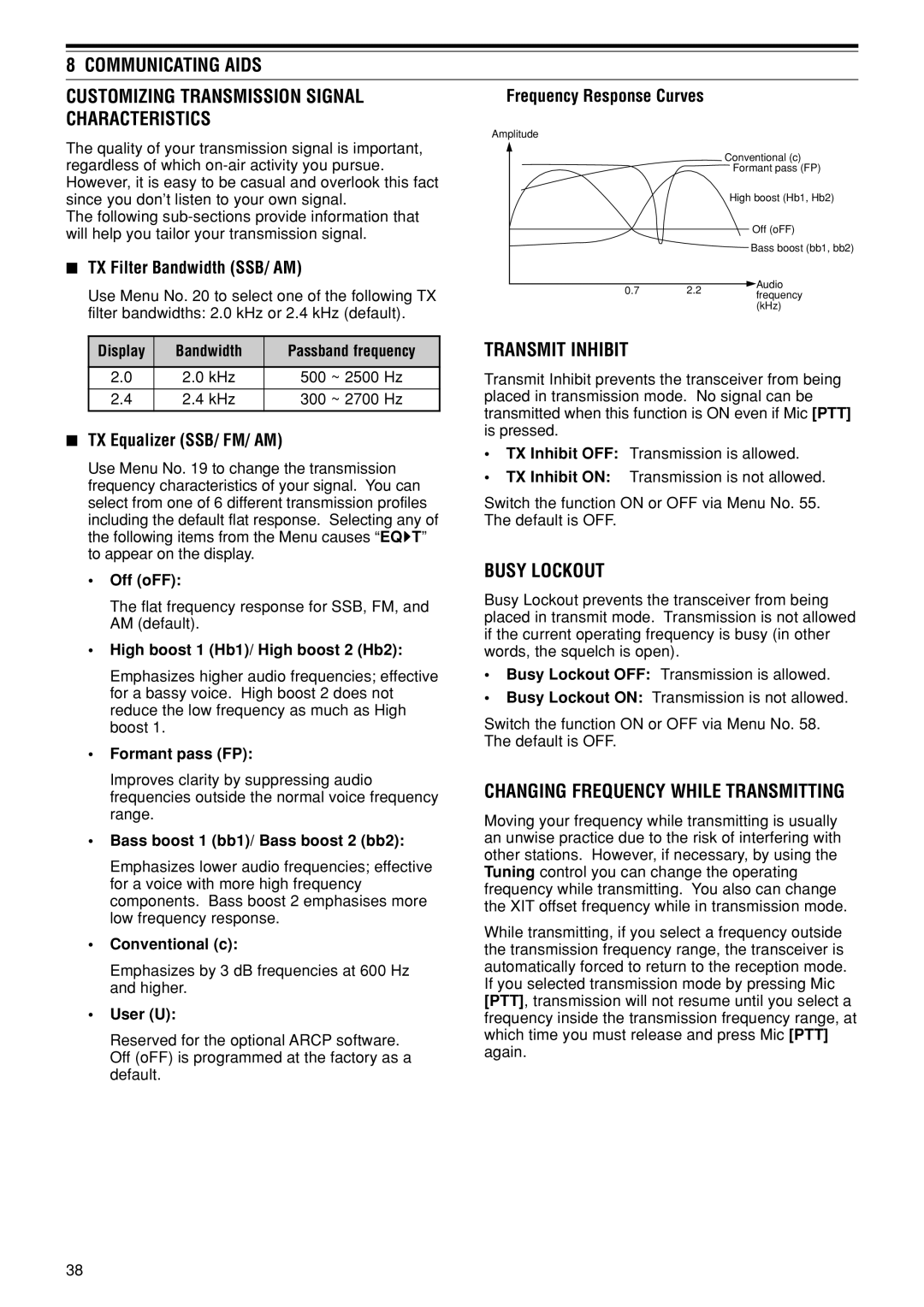
8 COMMUNICATING AIDS
CUSTOMIZING TRANSMISSION SIGNAL | Frequency Response Curves |
CHARACTERISTICS | Amplitude |
|
The quality of your transmission signal is important, regardless of which
The following
■ TX Filter Bandwidth (SSB/ AM)
Use Menu No. 20 to select one of the following TX filter bandwidths: 2.0 kHz or 2.4 kHz (default).
Display | Bandwidth | Passband frequency |
|
|
|
2.0 | 2.0 kHz | 500 ~ 2500 Hz |
|
|
|
2.4 | 2.4 kHz | 300 ~ 2700 Hz |
|
|
|
■ TX Equalizer (SSB/ FM/ AM)
Use Menu No. 19 to change the transmission frequency characteristics of your signal. You can select from one of 6 different transmission profiles including the default flat response. Selecting any of the following items from the Menu causes ÒEQsTÓ to appear on the display.
Conventional (c)
Formant pass (FP)
High boost (Hb1, Hb2)
Off (oFF)
Bass boost (bb1, bb2)
![]() Audio
Audio
0.72.2frequency (kHz)
TRANSMIT INHIBIT
Transmit Inhibit prevents the transceiver from being placed in transmission mode. No signal can be transmitted when this function is ON even if Mic [PTT] is pressed.
•TX Inhibit OFF: Transmission is allowed.
•TX Inhibit ON: Transmission is not allowed.
Switch the function ON or OFF via Menu No. 55. The default is OFF.
•Off (oFF):
The flat frequency response for SSB, FM, and AM (default).
•High boost 1 (Hb1)/ High boost 2 (Hb2):
Emphasizes higher audio frequencies; effective for a bassy voice. High boost 2 does not reduce the low frequency as much as High boost 1.
•Formant pass (FP):
Improves clarity by suppressing audio frequencies outside the normal voice frequency range.
•Bass boost 1 (bb1)/ Bass boost 2 (bb2):
Emphasizes lower audio frequencies; effective for a voice with more high frequency components. Bass boost 2 emphasises more low frequency response.
•Conventional (c):
Emphasizes by 3 dB frequencies at 600 Hz and higher.
•User (U):
Reserved for the optional ARCP software. Off (oFF) is programmed at the factory as a default.
BUSY LOCKOUT
Busy Lockout prevents the transceiver from being placed in transmit mode. Transmission is not allowed if the current operating frequency is busy (in other words, the squelch is open).
•Busy Lockout OFF: Transmission is allowed.
•Busy Lockout ON: Transmission is not allowed.
Switch the function ON or OFF via Menu No. 58. The default is OFF.
CHANGING FREQUENCY WHILE TRANSMITTING
Moving your frequency while transmitting is usually an unwise practice due to the risk of interfering with other stations. However, if necessary, by using the Tuning control you can change the operating frequency while transmitting. You also can change the XIT offset frequency while in transmission mode.
While transmitting, if you select a frequency outside the transmission frequency range, the transceiver is automatically forced to return to the reception mode. If you selected transmission mode by pressing Mic [PTT], transmission will not resume until you select a frequency inside the transmission frequency range, at which time you must release and press Mic [PTT] again.
38
